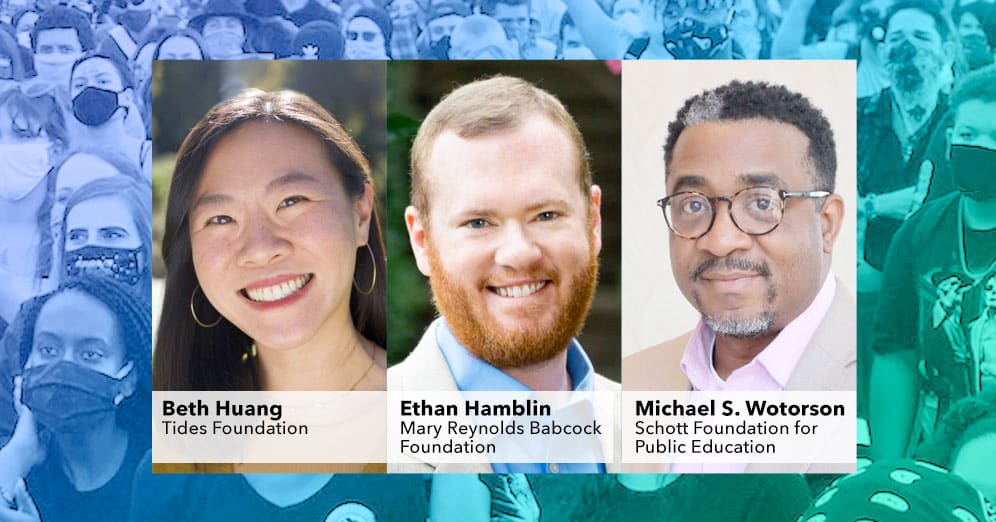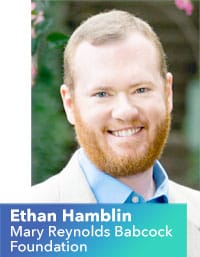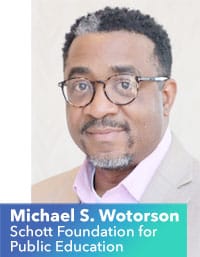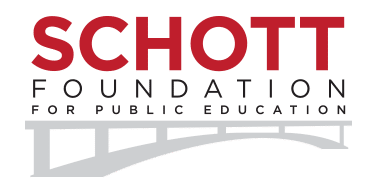How Can Funders Build Democracy Beyond Election Day?

We all use physical infrastructure when we vote, be it roads, rails, sidewalks, or the post office. But just as vital is our civic infrastructure: everything from poll workers and voter registration drives to neighborhood organizing and civics education in our public schools. Like its steel and concrete counterpart, our civic infrastructure requires more than just sporadic support, or resources only when crisis hits: it needs ongoing maintenance, support, and expansion.
Our grantee partners and allies have long raised the alarm over the episodic, boom-and-bust cycles of funding whenever a big election is looming. Sometimes mere weeks before an election, advocacy groups will see a flood of funding with an expectation they can use it to work miracles and spend it all before election day. But the kind of planning, canvassing, and staffing work that’s needed to make use of those funds should have started months earlier. Groups are faced with the choice of either turning down the money or making the best of a bad situation and risking failure to meet the donor’s expectations. Either way, the day after election day those groups are once again on their own.
Philanthropy is responding. In the face of this difficult dynamic, dozens of funders came together to sign the All by April pledge, in which they agreed to frontload their democracy and civic participation grants early in the year. “Early money enables groups to support communities during primary elections to identify concerns that need to be addressed ahead of November,” the statement reads. “As more and more jurisdictions allow for early and mail-in voting, nonprofits have even less time to plan their programs and need resources sooner. Further, nonprofits that are funded earlier are better prepared to put late money to more effective use.”
The principles underlying the pledge — that grantees need financial predictability to plan, that sporadic and sudden funding is an unfair burden, that simplifying the grantmaking process leads to better outcomes — can be applied to much more than democracy grantmaking.
In this issue, we interviewed three grantmakers about their strategies to strengthen our civic infrastructure.
Beth Huang is Civic Engagement & Democracy Program Officer at Tides Foundation. Ethan Hamblin is Senior Network Officer at Mary Reynolds Babcock Foundation. Michael S. Wotorson is Director of the National Opportunity to Learn Network at the Schott Foundation for Public Education.
Schott: Tides Foundation is a longstanding democracy grantmaker. This election season, how are you navigating the c3/c4 landscape to support your grantees and the larger project of strengthening democracy?
 Beth Huang: I lead the Healthy Democracy Fund, which is our pooled fund where we make decisions on strategy related to democracy grant making. Tides Foundation is a funding intermediary. As a public charity, not a private foundation, Tides Foundation can make lobbying expenditures, unlike private foundations, which cannot earmark funds for lobbying. Because Tides Foundation has a large budget, it means that we have tremendous lobbying capacity.
Beth Huang: I lead the Healthy Democracy Fund, which is our pooled fund where we make decisions on strategy related to democracy grant making. Tides Foundation is a funding intermediary. As a public charity, not a private foundation, Tides Foundation can make lobbying expenditures, unlike private foundations, which cannot earmark funds for lobbying. Because Tides Foundation has a large budget, it means that we have tremendous lobbying capacity.
Tides Foundation also has a very developed infrastructure for complex grantmaking to non-501c3s, which is why many social change leaders partner with Tides. It allows us to fund 501c4 organizations for their nonpartisan primary purpose. As your readers may know, 501c4s need to spend 60% of their budget on nonpartisan, non-electoral purposes. Tides is one of the few funders of these impactful nonpartisan programs housed at 501c4 organizations.
Tides Foundation has, through the Healthy Democracy Fund, awarded $5.7 million in grants to the ballot measures in Ohio last year to defend direct democracy as a tool for policy change in the August special election. And then we were also able to contribute to Ohio’s abortion access ballot measure in November last year. And it means that this year, we’ve made about $4 million in grants to date to the ballot measures in Florida, Colorado and Nevada for abortion access. We think that these are important drivers of voter participation, especially among the core constituencies for the Healthy Democracy Fund, which include people of color, young people, and working class people.
Babcock funds across eleven southern states. How are you and your grantees fitting the work of civic engagement in an election year to larger issue campaigns and movements?
 Ethan Hamblin: Babcock is a family foundation that is rooted within the South, we work to support ecosystems of networks and organizations that are working to build power to advance racial equity. The networks we support bring about systems change across a variety of pathways, including democracy and civic engagement policy work, as well as economic opportunity.
Ethan Hamblin: Babcock is a family foundation that is rooted within the South, we work to support ecosystems of networks and organizations that are working to build power to advance racial equity. The networks we support bring about systems change across a variety of pathways, including democracy and civic engagement policy work, as well as economic opportunity.
At Babcock’s very core, we believe people on the ground drive strategy, and our partners are the ones who we spend most of our time with: listening to them, to inform how and where we’re going to move resources.
In 2020, we named a commitment specifically to power building and racial equity, which means we began to think more intentionally in alignment with our partners to strengthen their strategies to build people power to not only control the levers of power, but to dismantle and rewrite the rules. Our grantee partners are working to build power across a variety of arenas, such as electoral, legislative or narrative change work.
How does civic participation and democracy intersect with racial and education justice in Schott Foundation’s grantmaking strategy?
 Michael S. Wotorson: Everything we do in our progressive spaces ultimately boils down to building and supporting the civic muscle. Philanthropy can ensure that civic organizations have the fuel necessary to plan and execute real strategies that protect and advance our democracy.
Michael S. Wotorson: Everything we do in our progressive spaces ultimately boils down to building and supporting the civic muscle. Philanthropy can ensure that civic organizations have the fuel necessary to plan and execute real strategies that protect and advance our democracy.
However, it is imperative to remember that waiting until an election to make support available is almost always far too late. Supporting civic infrastructure is as much about voter education as it is about registration; it’s also about protecting voting rights, responding to voter suppression tactics, and even helping to shore up press coverage of issues prior to elections.
Since Reconstruction, we’ve seen that racial justice in the schoolhouse and the voting booth advance — or retreat — in lockstep. Reactionaries and white supremacists attack our public schools to misinform us as voters and disorganize our neighborhoods and communities. They attack our ability to vote so they can deprive us of the power to shape the public institutions around us. Conversely, the victories we win in public education and voting rights form a virtuous cycle, each step forward making the next all the easier.
At Schott, how do we put this into practice? We ensure that grassroots voices and perspectives are elevated into the national discourse. We support intersectional efforts that recognize how our movements must rely on and grow with each other. Our support for organizations across issues and geography, like Girls for Gender Equity in New York, Californians for Justice, and One Voice Mississippi, is an important and necessary strategy for building the kind of resilient civic culture needed to not just defend, but advance.
For funders who are new to the democracy space, part of the allure of giving restricted grants for things like voter registration and GOTV is that they’re easily measurable. But we’ve seen the drawbacks of that kind of singular focus on output measurements, drawbacks that actually undermine the very motivation behind the grant. What do funders miss out on when they think of civic participation work — and their grantees doing the work — simply in terms of inputs and outputs?
Huang: It is easy to measure the number of doors that canvassers knocked, it’s easy to measure the number of dials that that phone banking software will make. But the numbers that are easiest to see are really the tip of a much larger iceberg, the rest of which is much harder to measure on a spreadsheet. An above-the-water metric might be “this organization has 700 members,” but the below the water factor might be that it took between two and ten one-on-one conversations to recruit each one of those members to the organization, and each one of those members is able to draw upon a whole network of neighbors and fellow parents in public schools and bring unlikely people out to out to vote in a given year.
Organizing requires building trust. You can’t build trust if you come to people’s doors in October, beg them to vote and then not come back until the following October. That’s not a recipe for building trust with people who often have lots of reasons not to trust that government is working for them. It’s just not possible to increase the amount of power that historically disenfranchised people have if we are only able to scale up and reach people late and very close to the election.
From the moment I was hired at Tides in January 2023, I heard a consistent drumbeat from our grantee partners: We need early funding. We need to be able to hire our organizers, to train our organizers, to bring on the canvas team and call through our volunteer list and do the first passes in our neighborhoods in the spring so that our people understand what our community’s interests and needs are.
I was recently on a call with union organizers in Arizona, who are forced to start voter canvassing and relational, door-knocking conversations in neighborhoods in the spring because the summers are too hot. As one of them put it, “we stop knocking at 115 degrees.” So we can’t wait until the brutal heat of summer is over before we have conversations with and mobilize Latino voters — it’ll be too late. So, the Arizona case is just one example of why funders need to get these resources to grantee partners as early as possible.
Hamblin: That’s right, we aren’t investing in outputs: we’re investing in people, and the work and strategies that they are developing. We can’t ask communities to turn up to election cycles without also engaging them year-round and meeting their needs. Because we take a long-term view, it also means that we build out networks of organizations, what we sometimes refer to as infrastructure, to not only respond during election cycles, but also be the first boots on the ground during a hurricane, or during an environmental crisis, or day-to-day turnout for state legislative cycles.
For example, in states like Alabama and Tennessee where there are some really amazing partners doing great work on the ground. This year is an opportunity for them to continue to build and expand a base of engaged voters. Regardless of electoral outcome, the “win” is more people engaged, more canvassing, more organizers, a deepened aligned strategy, and strengthened capacity for those organizations. That is what the win could look like. Our grantee partners will be very much working toward turning out voters, particularly in Alabama and Louisiana, where they now have new majority-Black districts due to congressional redistricting.
Wotorson: I think some funders tend to fundamentally misunderstand that successful democracy funding impacts far more than voting. Equally or perhaps even more important are issues like establishing checks against creeping authoritarianism, helping migrant or refugee communities build social capital to participate actively in the civic environment, and strengthening society’s democratic values.
This kind of societal shift takes real investment, and real time. Longer than your average grant cycle to be sure. But making the promise of a multi-racial democracy real is priceless. It values and elevates the perspectives and aspirations of the entire community.
John Dewey was on to something when he suggested that public schools were akin to basic democracy because the exchange between teachers and students unfolded (at least in theory) in an equitable fashion. The shared nature of discovery in education mirrors what a democratic society should look like: people sharing in decision-making, with the structures and practices of society drawn from those shared decisions.
I absolutely believe in the connection between democracy and public education. Public education as both process and concept helps us learn how to celebrate and protect freely associating to exchange thoughts, ideas, and suggestions on how to make our society better. Strengthening our democracy therefore requires we strengthen public education, so all children and families have access to an opportunity to learn and thrive.
For foundation staff and board members who are reading this and want to take first steps to moving their organizations toward funding this kind of work, what do you recommend? What should they keep in mind?
Huang: On our 501c3 grants, we’ve waived all reports. We don’t need our grantees to make them. We talk with them instead. The funder-grantee relationship has to be a two-way street. When I was leading non-profit organizations, my perspective was: if I’m going to spend an hour writing a report, and the funder is going to spend three minutes skimming through it, it would be basically the same amount of time if we spend 30 minutes talking to each other. But I think we’re both going to learn a lot more in that 30 minutes than what’s written in a grant report.
If we believe that trust building is an important component of power building, we need to think more than one year at a time when it comes to our grants. A lot of funders will ask grantees for multiple budget years into the future — why can’t we do the same for them, and ensure multi-year funding so they can plan more effectively? The issues that social justice movements are moving on are generational struggles. They won’t be solved in an election cycle, and certainly not in a grant cycle.
Hamblin: When we made our public commitments to racial equity and power building in 2020, that wasn’t something that just emerged in 2020 for Babcock. It was the result of years of deep analysis, relationship building, and conversations, both at the staff and board level going back before 2015 and 2016, when racial equity was becoming a widespread conversation in philanthropy.
There’s an opportunity, I think, to organize funders and philanthropy. As a sector we can figure out together what this moment really means for us, and how we can center racial equity at the very core of our principles, values, and funding strategies.
For those looking to shift their own grantee portfolio or larger organizational strategy, I’d say: deepen trust with your grantee partners, center their analyses in your staff and board strategies, and always lead with learning. Lead with listening to your grantee partners.
Wotorson: Creating a sustainable culture of civic responsibility cannot be achieved overnight. If that were possible, the logic proposition of abolishing slavery and eradicating Jim Crow would have achieved its goals in record time.
If your organization isn’t funding this kind of work yet, I suggest starting conversations with your fellow staff and board members, as well as your community partners. Build a plan to deepen organizational learning. Invite grassroots advocates to speak — and pay them for their time. Listen to what your current and prospective grantees’ priorities and visions of the future are, beyond the scope of your grant agreement.
Funders interested in supporting civic engagement must first understand that their support must be as deep and sustained as the systemic problems that face us. To that end, funders should focus on supporting community organizations that are intentional and authentic about confronting racial and gender injustice. By approaching support in this manner, funders can ensure that those voices become even more powerful pillars in building our democracy.

